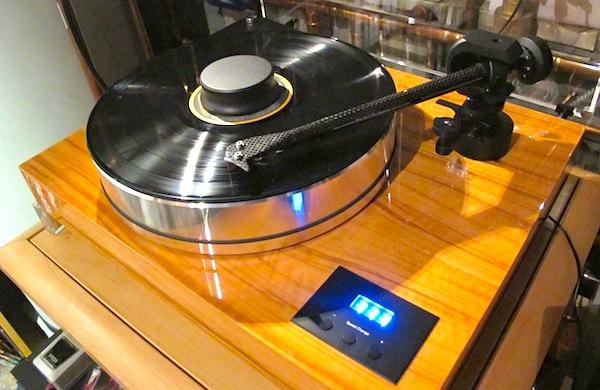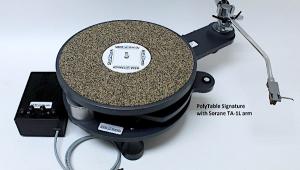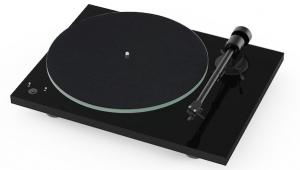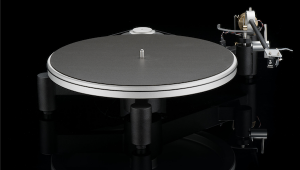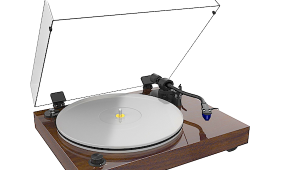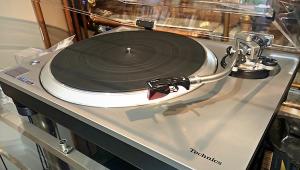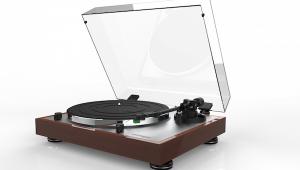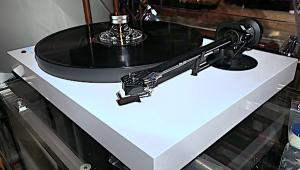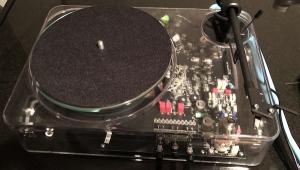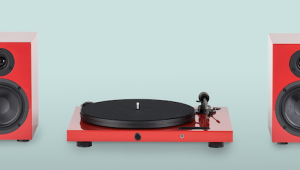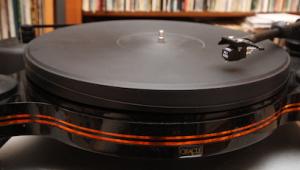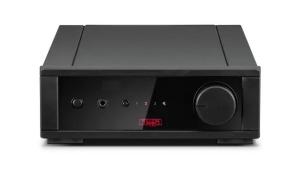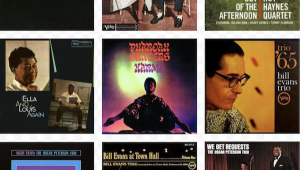The Pro-Ject Xtension10 Turntable— More Than a "Lifestyle" Product!
Success can have that effect.
Turntable Design Details
With its attractive wood-finished plinth and hinged heavy plexiglass dustcover (remember those?) the Xtension10 could be viewed as an over-achieving “lifestyle” turntable but that would be selling it way short.
The $2995 ‘table is a step down from the large, more expensive Xtension12, but that’s only if you are convinced that a 12” tonearm is better than a 10” one. I’m not. This one, at least, will fit on a standard rack shelf.
A $3699 “Superpack” option pairs the ‘table with importer Sumiko’s excellent high output moving coil Blackbird cartridge, which saves $399 over the regular $1099 price. The Blackbird has been around for a long time. How long? I reviewed it in the January 2004 issue of Stereophile! But if it ain’t broken, why fix it?
The 48 pound Xtension10 is definitely a mass-loaded design but it’s also a suspended one thanks to its four magnetically decoupled feet that do a superb job of isolating it from the outside world.
The plinth is of veneer covered MDF but judging by its considerable heft and its well-damped resonant behavior, I’d guess it’s been hollowed out and filled with sand and/or lead shot (thought that might not be legal).
The ceramic ball-topped inverted bearing is well-anchored into the plinth in its own circular sub-enclosure visible from the plinth bottom, which I suspect is where the extra weight and damping have been applied to give the plinth its surprisingly high mass.
Bonded to the 12.5 pound damped, balanced alloy platter of what is probably one of aluminum is a thick mat of well-machined recycled vinyl. The thrust pad incorporated into the platter is also of ceramic and though the product description doesn’t specify, the platter system is probably magnetically levitated to some degree.
I’m good with using mag-lev to reduce the full platter weight upon the thrust pad but dead set against a “floating” system because that produces a spring. When you rotate the platter, which you must to play a record (!) it’s going to bounce. Plus you eliminate the mechanical ground.
Drive is via an AC synchronous motor atop which is a precision dual pulley, though a built-in quartz oscillator driven electronic speed control (actually the circuitry used in the Speedbox SE that’s long been available as an “outboard” accessory) sets 33 1/3 and 45 ± a few percent in .1rpm increments. The second pulley allows you to play 78s.
The 10” EVO Carbon Fiber Arm
The arm—a variant of the separately available 10cc— of continuous carbon fiber from head shell to counterweight stub represents a high value “high tech” design in a ‘table, the total cost of which is under $3000. However, carbon fiber is not a “miracle” material. True, it is light-weight (effective mass 9 grams) and ultra-stiff but it also has a high resonant frequency that must be damped, and an arm whose mass, if too low, will not match well with low to medium compliance cartridges. But more about that later!
The ABEC7 quality bearings are set in a high mass housing giving the entire assemblage a precise, secure feel. Pro-Ject supplies three Sorbothane damped counterweights that can accommodate just about any weight cartridge.
Despite the fixed head shell, azimuth is adjustable by loosening grub screws and rotating the entire arm tube. VTA/SRA is also adjustable by loosening a pair of grub screws. Pro-Ject supplies a straight DIN to RCA cable that you can replace if you wish to try others but it’s not easily done. A Sorbothane damping sheet is the plinth/arm interface.
Set-Up
This is an easy to set up turntable. You screw into the plinth the four feet being careful to place the stiffly suspended one in the left front position where much of the weight is concentrated, place the platter on the bearing and if necessary use the feet to level the plinth. All that’s left to do then is fit the belt around the platter and pulley, affix the pulley cover plate using the three threaded chrome caps and connect the power supply. Oh, and place the dust cover onto the chromed hinge extensions.
The arm set-up is relatively straight forward. Having a gimbaled arm with azimuth adjustability at this price point is a real plus and while the VTA/SRA adjustment is coarse, at least it’s possible. You loosen the screws and the arm’s vertical shaft can be raised and lowered as desired but wherever you start you’d better make a mark of some kind on the shaft because if the sound is not to your liking, when you loosen the screws the arm will drop to its lowest position and without the reference mark you’re starting over.
Using a digital microscope and reference marks I was able to set 92 degree SRA but I’ve done it more easily! Anti-skating is the familiar weight and monofilament that loops over one of three notches in a difficult to access shaft protruding from the arm’s rear. VTF is set using the counterweight scale after leveling the arm and setting it to “0”. I have found both Pro-Ject’s VTF and anti-skating scales to be remarkably accurate but I still recommend
Using the Xtension10
The “on”/”off”, 33/45 speed choice and incremental adjustment control is located almost directly under the cartridge when the arm is at rest. It is not exactly an ergonomic delight and you have to be careful when pushing the buttons, or habituate yourself to a regimen of moving the arm above the lead-in groove before starting the platter. Not a big deal, just be careful!
You have to acclimate your fingers to how long to push the center of the three buttons. A short push starts the platter spinning at 33 1/3, but if you hold it down too long it will simultaneously start the platter and change the speed to 45. Again, this is not a big deal and just a slight learning curve.
A large fluorescent screen above the buttons tells you the chosen speed as well as the actual speed as the platter very slowly achieves the desired speed. Not a problem in my world. I don’t run a disco or radio station at home. Once it’s up to speed you can always leave the platter running. Pro-Ject also includes a high mass spindle weight.
The arm’s “vestigial” finger lift makes hand-cueing difficult. The lift is a small, slippery carbon fiber “outcropping” that’s difficult to handle. I suggest using the cueing mechanism.
Other than that, the ‘table proved trouble-free and a pleasure to use and listen to throughout the review period. It ran at precisely 33 1/3 and 45 and was easily “tweeked” to perfection or to run it a bit fast for say, when you play original pressings of Kind of Blue and Beggar’s Banquet, which were accidentally mastered at the wrong speed.
Xtension10 Sonics
This is the easy part of the review, in part because many of you have heard this ‘table on the files posted to this site for the phono preamp survey.
The Xtension10 runs at the right speed and its speed consistency is very good as the Feickert Platterspeed app demonstrates. 3150Hz is the test tone frequency and the Xtension10 can be adjusted to be right on the money. In fact, when the read out said 33.3, that was platter's measured speed. You can see on the graph that though the speed was perfect and the variations from speed were relatively minor that the pre-filtered waveform is somewhat jagged. The $175,000 Onedof turntable produced a perfect sine wave there, due in part to its superb bearing system.
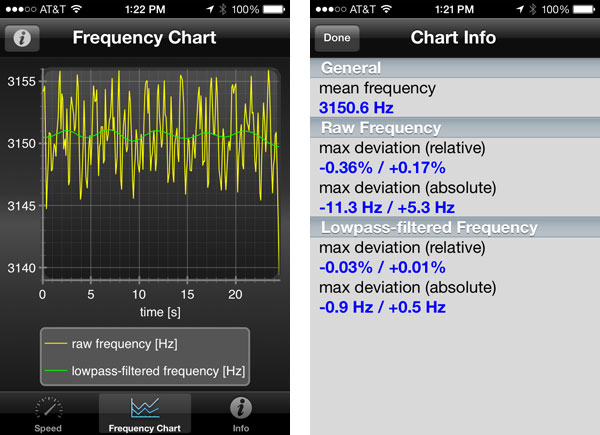
The ‘table’s low frequency performance is solid, well-extended free from overhang and the exaggerated warmth some suspended ‘tables exhibit. That’s because though the Xtension10 is suspended via its mag-lev feet, it’s also a mass-loaded design so you get sonic elements of both designs: the impactful, tight bass of a mass-loaded design and the smoothness and flow of one that’s suspended.
The ‘table exhibits excellent rhythm’n’pacing, which isn’t surprising given the bass performance but it’s enhanced by impressively clean transient performance, free of smear or softness.
In fact, if the ‘table has any easily identified sonic signature it would be a slightly over-accentuated attack and high frequency transient exaggeration.
For instance, on a great new Paul Rodgers album recorded, mixed and mastered AAA (The Royal Sessions [Pie 429 Records FTN 17972]), recorded at Willie Mitchell’s Royal Studios in Memphis, the female background singers on the opening track tend to blend into Rodgers’ vocals and mingle with the cymbals, whereas on other far more expensive rigs, they easily separate out. Rodgers’ vocals are slightly sharp too (not in pitch!). BTW: his voice is still incredible.
measured the arm/cartridge resonant frequency using the Blackbird and the Transfiguration Phoenix and both were in the desired 8-12Hz region, though right on the upper frequency borderline (11Hz), which is still fine.
The slight leading edge exaggeration means the Xtension10 would best be balanced by either a slightly soft cartridge or phono preamp, though the coloration or “personality” is so slight it might not be detectable in many systems.
I suspect that Pro-Ject’s Heinz Lichtennegger noted it. At CES 2014 he showed me a new process by which Pro-Ject will be damping future carbon fiber tonearms. Please don’t read too much into this criticism. It’s a very minor issue as anyone who listened to the Lehmann Black Cube SE II file can attest. That said, its character was not kind to the similarly but more prominently voiced PS Audio NuWave converter. I made sure to listen to that on other turntables to be sure the Xpression10 wasn’t overly exaggering the NuWave’s sonic performance (it wasn’t).
The ‘tables soundstaging abilities were very good in part because you can adjust the azimuth to maximize separation and channel balance and in equal part because of the arm’s excellent stiffness and the high quality bearings.
I thought the HO Blackbird was a great choice for the Xpresion10 but especially if you use it with a warmish phono preamp—and not necessarily one that’s tube-driven.
Despite a few small picky nits, the Xtension10 proved to be an eminently listenable reasonably priced turntable. I spent a few months listening and enjoying, especially to its black backgrounds, firm, well defined bass foundation and its expressive rhythmic drive. It’s a big ‘table with a big sound. Without seeing it you’ll know by the sound that it’s not a puny turntable.
Hell, tonearms of this build quality can cost as much as the entire package, though those who don’t like the “sound” of carbon fiber tone arms will find some ammunition here. With carefully matched associated equipment that should be a non-issue. The Xtension10’s main competition would be VPI’s $2800 Classic 1 turntable, Rega's RP8 and a few others. I am unable to make direct comparisons which is one of the inadequacies of this job. I wish that were possible. Conclusion
That said, for circa $3000 the Pro-Ject Xtension10 gives you a suspended mass-loaded turntable featuring a well-damped, attractive gloss-finished veneer plinth in a choice of three woods, a 12.5 pound alloy platter, a nicely done ceramic ball topped bearing, a built in quartz synthesized speed controller driving an A.C. synchronous motor, a 10” carbon fiber arm set in a high mass bearing housing featuring ABEC7 bearings and a dust cover. A good deal in my book.
